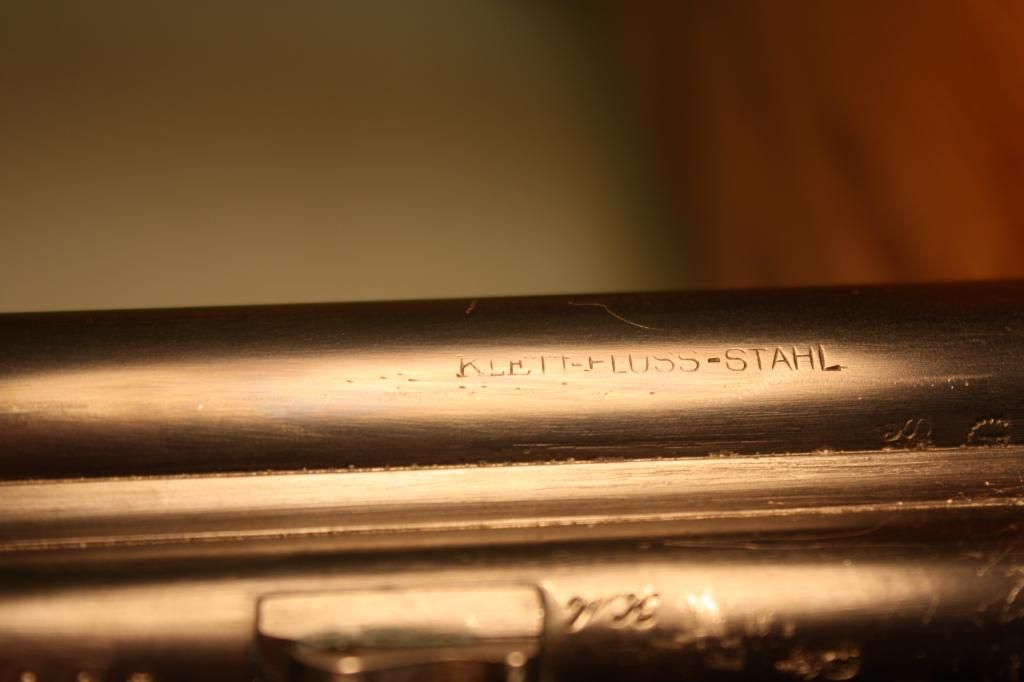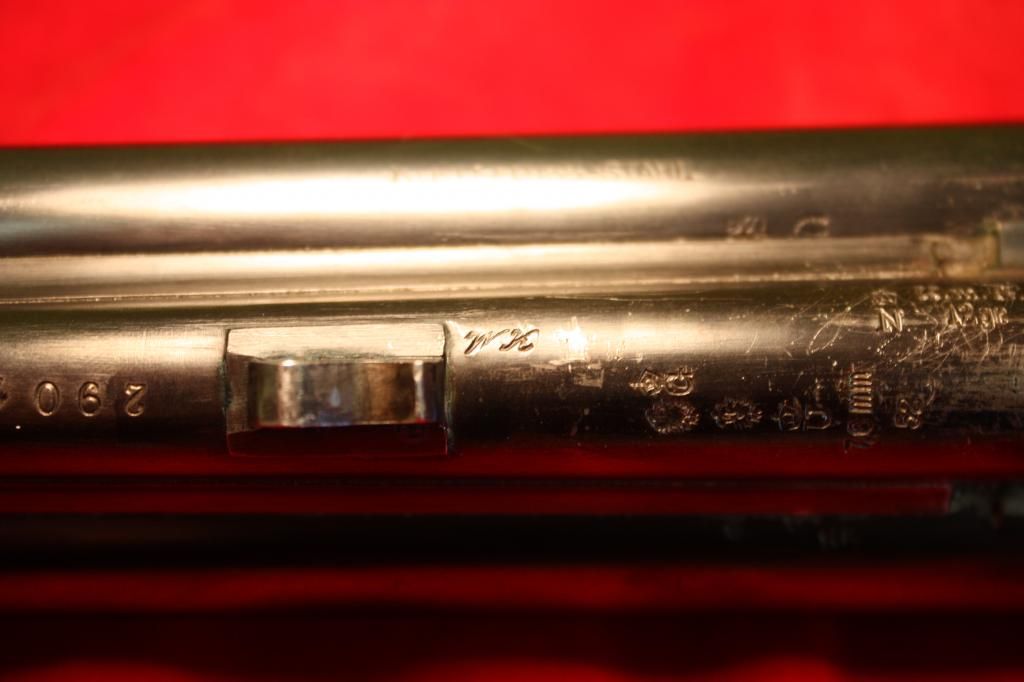Announcement
Collapse
No announcement yet.
I'm looking at a Christoph Funk Sporter
Collapse
X
-
No! As I wrote before, I have never seen a Suhl or Zella-Mehlis made or reblued gun with such a plum colored barrel. IMHO it's an American hot dip reblue job, done without proper heat control.Originally posted by sbakf View PostAxel - I know you either have some or access to some untouched, early 1900's, part-Mauser sporting rifles. Do any of them show plum colored barrels - i.e., barrels installed by the likes of Sauer and Funk?
Comment
-
As you may have noted, I (aka kuduae) posted this almost three years ago. By now I have learned a few things: The marks of the Kelbers are well known,a script L, similar to the British "Pound Sterling" symbol, or "LK" for Louis Kelber, "WK" for Wilhelm Kelber.Originally posted by sbakf View Post
SOMETHING FOUND (1):
http://forums.nitroexpress.com/print...35&type=thread
kuduae
(.375 member)
05/19/12 08:02 AM
Re: Mauser calibre ?
The "K in gear" may be a mark of the Suhl barrelmaker family Kelber. 7.7mm is the bore diameter at the time of proof. It may have been just short of 7.8mm, as it was measured using cylindrical gages. You have to add the groove depth. This marking is correct for the 8x57I with .318" bullets. The CROWN - crown/N proofmarks indicate pre-1923 proof using the "4000atm" special proof powder. As the bore diameter is given in mm and there are no other numbers, the gun was proofed in Suhl post-April 1, 1912.
The "K in spiked circle" mark is most likely that for one of the Klett barrelmakers. It seems to be a "speaking symbol", as a "Klette" or "Klett" in German is a burr, those spiked fruits that stick to your clothing or hair if you touch them in the bushes. Recently I have seen a Suhl barrel openly marked "KLETT LAUF" with another mark besides. It is a small HK with only one upright line in the middle, surrounded by a rhombus . This should be the mark of barrelmakers Hans Hermann Klett or his son Heinrich Christoph Klett.
If so, it leaves us with the F.A. Klett AG, founded in the 1800s, Hoffnung 21, Suhl, by 1925 run by a Hans Klett, as the user of the circled K mark.
Comment
-
The idea of the light alloy scope tubes with mounting rib underneath was protected by Hensoldt, Wetzlar, in 1932 by a DRGM. The 4x Dural - Dialytan scopes were first advertized by Hensoldt in April 1933. The 6x DURALYT scopes came later. So scope and mount tops can not be original to a pre-WW1 rifle.Last edited by Axel E; 04-14-2015, 10:33 AM.
Comment
-
Axel: Speaking of barrel makers' marks, have you seen K followed by an equal sign (K=) within a rhombus? This is marked twice on the barrel of my 1910 or so German sporter on an Oberndorf action, one above the other. I understand this perhaps indicates the barrelmaker whose mark this is (assuming it's a barrelmaker's mark) rifled and chambered this barrel. The barrel is stamped KRUPP STAHL on the bottom flat, and the same engraved on the left flat of the barrel above. Dan
Comment
-
A photo, please! "Krupp Stahl" merely means the barrel is made of steel by the Krupp steelworks. As the "name" Krupp steel was used by practically everyone, it is of no use in identifying a maker.Originally posted by Dan Patch View Posthave you seen K followed by an equal sign (K=) within a rhombus?
Comment
-
Axel: I suppose even mentioning Krupp was misleading, as I wasn't thinking of associating the "K plus equal sign in rhombus" mark with Krupp, but rather perhaps with a Suhl-area barrel maker like one of the Klett or Kelber families. I don't presently have any means of recording images, but the barrel itself is pretty typical of the type: 8 x 57 caliber, half octagon/half round, matted rib, lug for barrel wedge, sling swivel forward of the fore-end. No maker's name; barrel marked as passing a 7.7 m/m gage, proofing load cited on left side of receiver ring indicates use of 2.5 g of rifle flake powder. Dan
Comment
-
the "Klett-Fluss-Stahl" and the "K in jagged circle" marks are on the shot tube, while the script "WK" mark is on the rifle barrel. Wilhelm Kelber was a renowned rifle barrel maker. Other than his brother's Louis' mark, the script WK is most often found on rifle barrels only. Barrel boring, rifling, jointing and rib laying were different Jobs in Suhl, performed by different shops and/or craftsmen most often. When I visited Max Schilling`s "chicken shack" shop at Gothaer Str., Suhl, in 1991, his rifling machine was busy rerifling bolt action barrels, while he and his only journeyman scratched excess hard silver solder from drilling and combination barrel assemblies he had jointed for the BÜHAG gunmakers. Schilling did not make the shot tubes, but got them from the former ETW. His rifle barrels were rough bored before by another shop that specialized in deep hole drilling. Putting on the ribs was done by others. So Wilhelm Kelber's WK may stand for rifling the rifle barrel, while the block letter WK is for the barrel jointer. Barrel jointing and soft sodering on the ribs were jobs of the "Rohrmacher" in Suhl. W.W,Greener wrote "jointing", not "knitting". The job of the Rohrmacher did not extend to boring and rifling the barrels traditionally. According to Greener a Birmingham "barrel filer" or a London "barrel maker" did the same work. They too got the shaped, fine bored and rifled barrels from the barrel borer.Last edited by Axel E; 04-12-2015, 04:20 PM.
Comment
-
IMHO it's an American hot dip reblue job, done without proper heat control. Axel E
I agree – seems all available evidence points to such. Besides the plum colored barrel, with a blue/black colored action, there is another tell-tale sign. Although the stampings on the barrel (shown before), receiver ring and trigger/mag assembly appear seemingly untouched (i.e., as orginal), the exposed top numbers/letters/proof stamps on the bolt assembly are fuzzy looking. That is, they’re not sharp/strong in presentation. I’m pretty certain this bolt had a previous rusting problem – with rather significant damage done (i.e. pitting) where handle meets bolt body. Diminished depth and dulled edges, vis-à-vis buffing wheel, are like old footprints in the snow. (see attached photos)
DSC02611.jpg (COMPRESSED).jpg DSC02569.jpg (COMPRESSED).jpg DSC02584.jpg (COMPRESSED).jpg DSC02710.jpg (COMPRESSED).jpg
As you may have noted, I (aka kuduae) posted this almost three years ago. By now I have learned a few things: The marks of the Kelbers are well known,a script L, similar to the British "Pound Sterling" symbol, or "LK" for Louis Kelber, "WK" for Wilhelm Kelber. Axel E
Haven’t we all. With that being said, that old thread started with the question:
The ? is calibre, on the LR it's marked as follows - 2,5gGBP and a large S - is this an 8x60 vs an 8x57? or does the S have another meaning? Any comments appreciated. --- John303
http://forums.nitroexpress.com/showf...rue#Post207835
A question quite similar to one posed here repeatedly (Postings #4, #12 & #25). For example -“What is your idea about the “S” stamped on the action of the FUNK?” I’ve been looking, but haven’t found a definitive answer to this question in any internet posting(s).
It’s been stated/suggested here:
The "S" bore came in ca. 1905 and after 1920 was restricted. (Mike, Posting #2)
The bore is marked 7.8, which would match to 0.318-0.320" groove dia., but the action has an "S" stamped on it. … I wonder if it is one of the civilian hunting rifles pressed into service as a sniper rifle until supply caught up, and were replaced. They were inspected and marked by a plaque on the stock, whether for "I" or "IS" ammo. If so, it may have been rebarreled after the war to meet restrictions on "IS" rifles. (Mike, Posting #4)
NOTE:
My FUNK sporter doesn’t have an eagle stamp, as shown below.
MY GUNS - EAGLE STAMPING FOR GERMAN SNIPER RIFLE - NITRO EXPRESS LINK 10533537yj.jpg
This eagle is a military acceptance stamp applied by the Prussian Spandau arsenal in 1915. During the first part of WW1 many scoped sporting rifles volunteered and soldiered as stop-gap sniping rifles. (RE: above NitroExpress link)
The "K in spiked circle" mark is most likely that for one of the Klett barrelmakers. It seems to be a "speaking symbol", as a "Klette" or "Klett" in German is a burr, those spiked fruits that stick to your clothing or hair if you touch them in the bushes. Recently I have seen a Suhl barrel openly marked "KLETT LAUF" with another mark besides. It is a small HK with only one upright line in the middle, surrounded by a rhombus . This should be the mark of barrelmakers Hans Hermann Klett or his son Heinrich Christoph Klett.
If so, it leaves us with the F.A. Klett AG, founded in the 1800s, Hoffnung 21, Suhl, by 1925 run by a Hans Klett, as the user of the circled K mark. Axel E
Thanks Axel, appreciate this FYI – it will surely be included in the descriptive summary (notebook) I’m compiling on this FUNK sporter.Last edited by sbakf; 04-13-2015, 02:06 PM.
Comment
-
That S on the side of the receiver ring is mysterious to me. The 2.5 gramm GBP charge and the 7.8 mm bore diameter both point to the M88 8x57I with the 227 gr rn bullet at 2130 fps. The sporting rifles drafted to WW1 sevice , suitable for using the S cartridge, were marked with the military acceptance eagle on a barrel flat and a Z-prefix registration number on the right side of the buttstock, see "Waidmannsheil # 47". This marking may be sanded off after the war. On the other hand that S resembles the S stamped on top of the receiver ring of M88/S and M88/05 rifles converted for using the 8x57IS cartridge by opening up chamber and throat. A further hint may be found in the 1934 RWS handbook, page 38: "If one wants to shoot the 8mmS bullets with the larger diameter from a barrel built for the long-bullet 8x57I cartridge, he should not miss to have the neck area of the chamber and the throat opened up by a gunsmith." This alteration may have been done to the rifle, either in early 1915 by a military armorer, before the recall and inspection, or in the 1930s by the civilian gunsmith who mounted the new Hensoldt light alloy scope on the pre-WW1 bases.Last edited by Axel E; 04-13-2015, 04:05 PM.
Comment












Comment